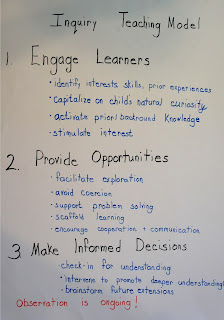Teaching Science to ELL's
Key Strategies every Science teacher should know
Since 1995, the amount of English Language Learners in the United States has risen substantially. Teaching ELL students is a difficult and sometimes daunting task for educators that are not trained in working with ELL learners. Because these students primarily have a hard time understanding the language, their main focus is not on learning content in the classroom. However, if educators can the implement the strategies presented in this article effectively, ELL students should be able to continue developing their English language skills while learning and understanding the academic content. Implementing these strategies in an effective way will also show teachers how to plan and implement their instruction.

The strategies and research presented in this article have a huge influence on Science teaching. Students depend on us, (educators) to help them learn the language needed to understand the content we teach. In order to help these students better develop their language proficiency, teachers need to make connections and provide opportunities.
For example: When teaching the concept of different forms of precipitation, a student from another country may not understand the concept of snow if they have never lived in an area where it snows. However, chances are this student has an understanding of rain and cold weather. Teachers can make a connection for these students between rain (which they have experienced) and freezing temperatures and demonstrate how snow can be formed. To check a students understanding of how snow forms, students could do an experiment with water and freezing temperatures over the course of a few days. Give the student many options of ways to express their understanding of forms of precipitation.
 |
| Example of student work - precipitation (modeling) |
Instructing ELL students is a partnership between the general education instructor and the ESL teacher. Without this partnership, content teachers struggle to meet the needs of their ESL students. In an ideal world, content teachers will always have the assistance of an ESL teacher to help them instruct these students. However, many schools do not have the resources needed to instruct these students individually and it is up to teachers to differentiate their instruction to accommodate these students.
I think that this article is significant to the field of science teaching because students learn through exploration and investigation in Science. The strategies in this article are appropriate for teaching all subjects but especially Science because they focus on opportunity, interaction, representation and exploration which are key components to teaching science concepts.
 |
| English/Spanish Science Flash Cards |
Content teachers do not have the knowledge and skills to accommodate these students. The research presented here gives teachers a way to create their own improvisations when training is not provided. Also, in my opinion, the way students develop language is significant to teaching science to ESOL students. People generally believe that language development and content learning happen interdependently. However, research and literature show that language development is achieved most effectively while in the context of content learning. Before introducing a new concept to ELL students, teachers could provide a vocabulary list of the language that will be used prior to teaching the new topic. These students will have time to learn to build their proficiency of the language before the concept is even introduced.
Basic interpersonal communication skills (BICS) are picked up by humans quickly and naturally and academic language proficiency (ALP) takes years to develop. This serves as a huge impact to a students learning, and is an even greater impact on ELL students. Teachers should be aware of this fact when instruction ELL students. These individuals need ample time to learn the language and vocabulary of content in order to gain proficiency. In my classroom I will do my very best to scaffold language to maximize language development.
| 1st grade - Science exploration |
Also, as a content teacher I will do a lot of rephrasing when giving directions and instructions to ELL students. Posters and visual representations are an easy way to allow students to engage in the language while decreasing any anxiety that they may have. I will use as many forms of visual representations as possible in my classroom when teaching all subjects and especially science. In addition to providing multiple means of representation for students, I will also provide ample opportunities for interaction. Allowing students to negotiate with other students in cooperative learning groups or even peer-to-peer connections allows ELL students to further develop their language proficiency skills. Teachers should lower language barriers to show progress in science and not level of proficiency.
| Water Cycle - Visual representation |
| Water Cycle - written report |
| Our students are our future! Reference:
Bautista, N., & Castaneda, M. (2011). Teaching Science to ELLs, Part I. The Science Teacher, 78 (3), 35-39.
|

No comments:
Post a Comment